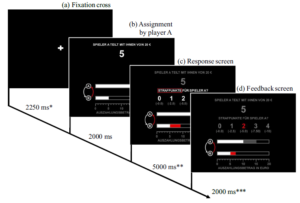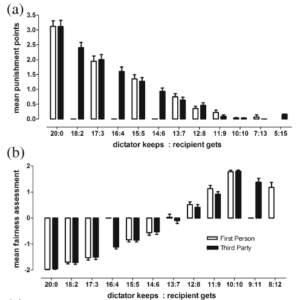Dictators are dictators but they are not all equally dictatorial—at least in the laboratory, when participants are given an amount of money to allocate between themselves and a recipient. In the classic dictator game, recipients are powerless and have to settle for whatever amount the “dictator” allocates to them.
In sharp contrast to the expectations of game theory based on the fabled Homo Economicus, laboratory dictators on average allocate 25% of their funds (or more) to the recipient. That is, rather than grabbing it all and thumbing their nose at the poor recipient, most of us share our funds even when there is no one around to enforce our altruism.
As we saw in a recent post on this blog, people are by and large altruistic. Even soldiers require a lot training to overcome their reluctance to fire at the enemy. (Sadly, this training can be quite successful.)
So where does this altruism come from? What are the mechanisms by which it is supported and preserved? One influential view holds that altruism is necessary for societies to function cooperatively, and that it is therefore enforced by two processes: altruistic rewarding and altruistic punishment.
That is, we reward others for cooperative behavior, and conversely, we punish cooperative norm violations of others even if we stand nothing to gain from the punishment. Thus, when a third party is introduced into the dictator game, that person will tend to punish the dictator for any allocation to the recipient that falls below 50%.
A recent article in the Psychonomic Society’s journal Cognitive, Affective, and Behavioral Neuroscience further examined the role of altruistic punishment in the dictator game. Researchers Mothes, Enge, and Strobel were particularly interested in the individual differences underlying altruistic punishment, and how those differences might express themselves in brain activity during the task.
Mothes and colleagues therefore focused on event-related brain potential (ERP) markers. ERPs are a long-standing tool in experimental cognitive psychology and they provide a measure of cognitive activity without requiring a behavioral response. The ERP signal in response to a stimulus can be broken into several distinct components, and in some instances previous research provides sufficient constraints for ERPs to be reliable fingerprints of cognitive activity.
In the present study, Mothes and colleagues focused on the so-called feedback-related negativity (FRN) that is elicited around a quarter of a second (250 ms) after a person obtains feedback about outcomes that are worse than expected. The FRN is measured with the usual electrodes affixed to the participant’s head and originates towards the front and center of the scalp. It has previously been associated with activity in a brain structure known as the anterior cingulate (ACC) which is known to be involved in the processing of conflict and reward prediction errors.
Participants in the study played two different roles: In one role, they were the recipient of an allocation made previously by another participant who served as dictator (but whom they never saw or interacted with). In the other role, participants merely witnessed the allocation from one participant to another. On half the trials in each role, participants rated the perceived fairness of the allocation, whereas on the remaining half of trials participants could award “punishment points” to the dictator. Any punishment point awarded to the dictator reduced the dictator’s allocation by 2.50 Euros, but it also reduced the player’s own final reward—punishment therefore incurred a slight cost to the participant.
The figure below shows a single trial in which a dictator has allocated 5 (out of 20) Euros to the participant, who in return “awards” 2 punishment points to the dictator. Thus the dictator’s final payoff was reduced from 15 Euros to 10 Euros.

The behavioral results are shown in the next figure. The top panel (a) plots the punishment points “awarded” to the dictator as a function of the allocation on half the trials. Clearly, if the dictator keeps the entire 20 Euros, they get severely punished. The punishment goes towards zero if the dictator splits the amount fairly into two equal halves. Intriguingly, it does not appear to matter much if participants are at the receiving end of the dictator’s actions or if they merely observe the fate of a third, unknown person.

The bottom panel (b) shows the fairness judgments that were collected on the other half the trials. The pattern is equally straightforward: Dictators are judged to be unfair if they keep any more than 13 out of 20 Euros, and the fairness peaks at the even allocation (10:10). Again, it does not matter if the participant is the recipient or an unknown third person.
Turning to the ERP data, the next figure shows the magnitudes of the FRN as a function of perspective (i.e. whether the participant or third party was at the receiving end of the dictator) and whether or not the allocation was fair (i.e., 10:10).

Although it appears as though perspective matters, the only statistically detectable effect was for fairness: Unfair allocations evoked a greater FRN than fair allocations and statistically it did not matter whether the participant or a third party were at the receiving end of that unfairness.
These data suggest that the part of the brain that is often implicated in conflict detection and resolution is particularly active when people detect a violation of fairness norms. When the participants themselves were at the receiving end of that unfairness, larger FRN amplitudes were also (weakly) associated with punishment behavior.
Concerning individual differences, the overall pattern was relatively subdued, with few strong correlations between various personality and attitude measures and the behavioral or neural measures. There was, however, one intriguing effect: higher “positive affectivity” at the beginning of the experiment—that is, greater happiness—predicted greater punishment of unfair dictators. This result is consonant with previous findings that positive affect can promote helpfulness and concerns for fairness, and it suggests that “positive emotions play an important role in initiating actions to restore violated fairness norms”.
This may explain why in the LEGO movie, things didn’t turn out all that well for the dictator despite everything being awesome:
[youtube https://www.youtube.com/watch?v=StTqXEQ2l-Y]
Focus article of this post:
Mothes, H. Enge, S. & Strobel, A. (2016). The interplay between feedback-related negativity and individual differences in altruistic punishment: An EEG study. Cognitive, Affective, and Behavioral Neuroscience. DOI: 10.3758/s13415-015-0388-x
